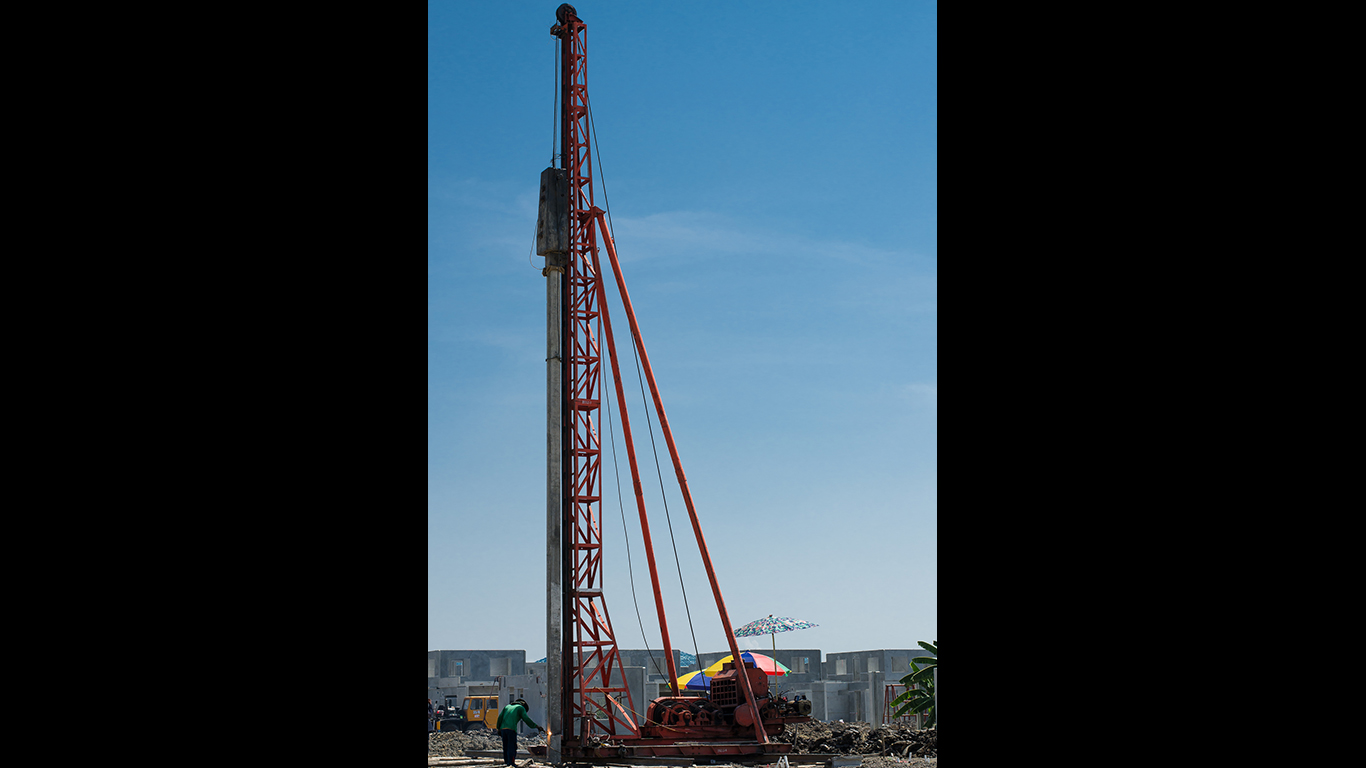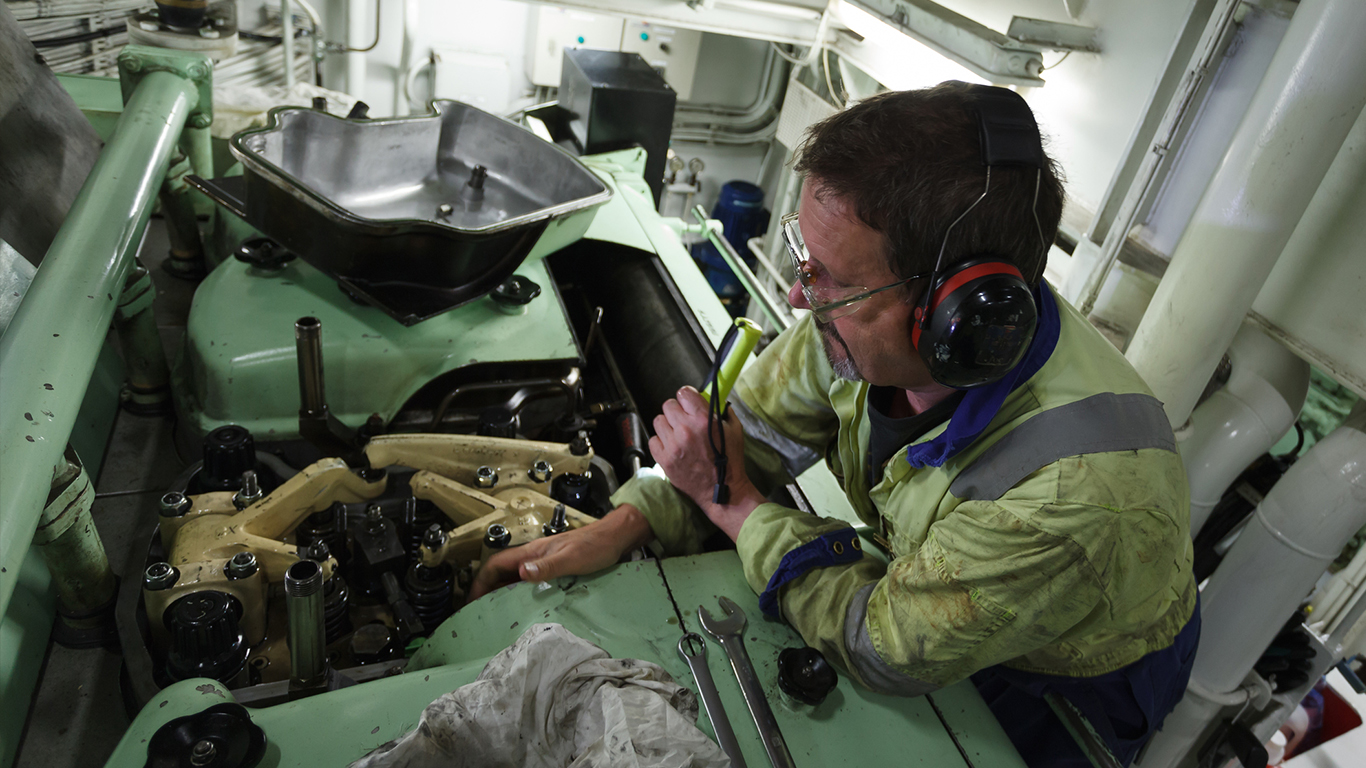Special Report
Highest Paying Jobs You Can Get Without a College Degree

Published:
Last Updated:

Though a postsecondary education improves one’s chances of finding a high-paying job, college enrollment has been declining in the United States in recent years, likely due to rising tuition costs. However, though a bachelor’s degree greatly increases an individual’s earnings potential, there are still many high-paying jobs that do not require higher education but instead value experience, training, and skill.
While the median income of a typical American adult with at least a bachelor’s degree is $52,782, the median income of those with a high school diploma is just $31,600 per year. Some jobs that do not require a college education, however, pay well more than the median across all education levels.
24/7 Wall St. reviewed Bureau of Labor Statistics occupation data to find the 50 highest paying jobs that do not require a college education.
Some of these jobs are in management roles and higher-ranking positions, accessible to those who worked their way up from low-level positions at jobs that do not require a degree, such as law enforcement or sales. Many of these jobs require years of on-the-job experience or training, and some require specific credentials or licenses.
None of these 50 jobs requires a bachelor’s degree, and yet they all make at thousands more than the typical American worker’s wage of $37,360. The median income of 10 jobs on this list is more than double the national median.
Click here to see the highest paying jobs you can get without a college degree.
Click here to see our detailed findings and methodology.

50. Railroad brake, signal, and switch operators
> Median annual wage: $57,260
> Typical on-the-job training needed: None
> Total employment: 19,300
> Employment growth projection (2016-2026): -1.6%
[in-text-ad]

49. Postal service mail sorters, processors, and processing machine operators
> Median annual wage: $57,260
> Typical on-the-job training needed: None
> Total employment: 106,700
> Employment growth projection (2016-2026): -16.5%

48. Executive secretaries and executive administrative assistants
> Median annual wage: $57,410
> Typical on-the-job training needed: Less than 5 years
> Total employment: 685,300
> Employment growth projection (2016-2026): -17.4%

47. Rail car repairers
> Median annual wage: $57,460
> Typical on-the-job training needed: None
> Total employment: 22,300
> Employment growth projection (2016-2026): +5.2%
[in-text-ad-2]

46. Pile-driver operators
> Median annual wage: $57,650
> Typical on-the-job training needed: None
> Total employment: 3,700
> Employment growth projection (2016-2026): +14.6%

45. Roof bolters, mining
> Median annual wage: $58,450
> Typical on-the-job training needed: None
> Total employment: 3,700
> Employment growth projection (2016-2026): -5.2%
[in-text-ad]

44. Postal service clerks
> Median annual wage: $58,550
> Typical on-the-job training needed: None
> Total employment: 79,000
> Employment growth projection (2016-2026): -12.1%

43. Property, real estate, and community association managers
> Median annual wage: $58,670
> Typical on-the-job training needed: Less than 5 years
> Total employment: 317,300
> Employment growth projection (2016-2026): +10.3%

42. First-line supervisors of production and operating workers
> Median annual wage: $58,870
> Typical on-the-job training needed: Less than 5 years
> Total employment: 621,400
> Employment growth projection (2016-2026): -0.3%
[in-text-ad-2]

41. Construction and building inspectors
> Median annual wage: $59,090
> Typical on-the-job training needed: 5 years or more
> Total employment: 105,100
> Employment growth projection (2016-2026): +10.0%

40. Fire inspectors and investigators
> Median annual wage: $59,260
> Typical on-the-job training needed: 5 years or more
> Total employment: 12,300
> Employment growth projection (2016-2026): +7.3%
[in-text-ad]

39. Makeup artists, theatrical and performance
> Median annual wage: $59,300
> Typical on-the-job training needed: None
> Total employment: 4,800
> Employment growth projection (2016-2026): +12.5%

38. Stationary engineers and boiler operators
> Median annual wage: $59,890
> Typical on-the-job training needed: None
> Total employment: 35,700
> Employment growth projection (2016-2026): +4.8%

37. Railroad conductors and yardmasters
> Median annual wage: $60,300
> Typical on-the-job training needed: None
> Total employment: 41,800
> Employment growth projection (2016-2026): -2.1%
[in-text-ad-2]

36. Locomotive firers
> Median annual wage: $60,360
> Typical on-the-job training needed: None
> Total employment: 1,200
> Employment growth projection (2016-2026): -78.6%

35. Electrical and electronics installers and repairers, transportation equipment
> Median annual wage: $60,840
> Typical on-the-job training needed: None
> Total employment: 13,900
> Employment growth projection (2016-2026): +2.9%
[in-text-ad]

34. Locomotive engineers
> Median annual wage: $60,990
> Typical on-the-job training needed: Less than 5 years
> Total employment: 38,800
> Employment growth projection (2016-2026): -2.8%

33. Aircraft mechanics and service technicians
> Median annual wage: $61,020
> Typical on-the-job training needed: None
> Total employment: 132,000
> Employment growth projection (2016-2026): +4.9%

32. Police and sheriff’s patrol officers
> Median annual wage: $61,050
> Typical on-the-job training needed: None
> Total employment: 684,200
> Employment growth projection (2016-2026): +7.0%
[in-text-ad-2]

31. Insurance appraisers, auto damage
> Median annual wage: $62,100
> Typical on-the-job training needed: None
> Total employment: 17,600
> Employment growth projection (2016-2026): +4.9%

30. Chemical plant and system operators
> Median annual wage: $62,170
> Typical on-the-job training needed: None
> Total employment: 33,200
> Employment growth projection (2016-2026): -9.2%
[in-text-ad]

29. Boilermakers
> Median annual wage: $62,260
> Typical on-the-job training needed: None
> Total employment: 17,200
> Employment growth projection (2016-2026): +9.0%

28. First-line supervisors of correctional officers
> Median annual wage: $62,500
> Typical on-the-job training needed: Less than 5 years
> Total employment: 45,200
> Employment growth projection (2016-2026): -7.8%

27. Gas compressor and gas pumping station operators
> Median annual wage: $62,810
> Typical on-the-job training needed: None
> Total employment: 3,900
> Employment growth projection (2016-2026): +3.4%
[in-text-ad-2]

26. First-line supervisors of construction trades and extraction workers
> Median annual wage: $64,070
> Typical on-the-job training needed: 5 years or more
> Total employment: 602,500
> Employment growth projection (2016-2026): +12.6%

25. First-line supervisors of mechanics, installers, and repairers
> Median annual wage: $64,780
> Typical on-the-job training needed: Less than 5 years
> Total employment: 462,200
> Employment growth projection (2016-2026): +7.1%
[in-text-ad]

24. Claims adjusters, examiners, and investigators
> Median annual wage: $64,900
> Typical on-the-job training needed: None
> Total employment: 311,100
> Employment growth projection (2016-2026): -1.4%

23. Subway and streetcar operators
> Median annual wage: $66,420
> Typical on-the-job training needed: None
> Total employment: 12,800
> Employment growth projection (2016-2026): +4.1%

22. Petroleum pump system operators, refinery operators, and gaugers
> Median annual wage: $67,770
> Typical on-the-job training needed: None
> Total employment: 41,800
> Employment growth projection (2016-2026): +2.8%
[in-text-ad-2]

21. Signal and track switch repairers
> Median annual wage: $68,400
> Typical on-the-job training needed: None
> Total employment: 10,000
> Employment growth projection (2016-2026): +1.3%

20. Gas plant operators
> Median annual wage: $69,030
> Typical on-the-job training needed: None
> Total employment: 17,300
> Employment growth projection (2016-2026): +0.0%
[in-text-ad]

19. Electrical power-line installers and repairers
> Median annual wage: $69,380
> Typical on-the-job training needed: None
> Total employment: 120,900
> Employment growth projection (2016-2026): +13.9%

18. Farmers, ranchers, and other agricultural managers
> Median annual wage: $69,620
> Typical on-the-job training needed: 5 years or more
> Total employment: 1,028,700
> Employment growth projection (2016-2026): -0.8%

[in-text-ad-2]

16. Captains, mates, and pilots of water vessels
> Median annual wage: $70,920
> Typical on-the-job training needed: Less than 5 years
> Total employment: 38,800
> Employment growth projection (2016-2026): +8.8%

15. First-line supervisors of non-retail sales workers
> Median annual wage: $71,650
> Typical on-the-job training needed: Less than 5 years
> Total employment: 405,200
> Employment growth projection (2016-2026): +4.9%
[in-text-ad]

14. Transportation inspectors
> Median annual wage: $72,140
> Typical on-the-job training needed: None
> Total employment: 28,200
> Employment growth projection (2016-2026): +5.9%

13. Gaming managers
> Median annual wage: $72,930
> Typical on-the-job training needed: Less than 5 years
> Total employment: 4,500
> Employment growth projection (2016-2026): +2.5%

12. Ship engineers
> Median annual wage: $73,110
> Typical on-the-job training needed: Less than 5 years
> Total employment: 10,100
> Employment growth projection (2016-2026): +6.5%
[in-text-ad-2]

11. Postmasters and mail superintendents
> Median annual wage: $74,840
> Typical on-the-job training needed: Less than 5 years
> Total employment: 14,200
> Employment growth projection (2016-2026): -20.9%

10. First-line supervisors of fire fighting and prevention workers
> Median annual wage: $76,170
> Typical on-the-job training needed: Less than 5 years
> Total employment: 59,100
> Employment growth projection (2016-2026): +7.2%
[in-text-ad]

9. Power plant operators
> Median annual wage: $77,180
> Typical on-the-job training needed: None
> Total employment: 36,100
> Employment growth projection (2016-2026): +1.3%

8. Electrical and electronics repairers, powerhouse, substation, and relay
> Median annual wage: $78,410
> Typical on-the-job training needed: Less than 5 years
> Total employment: 23,400
> Employment growth projection (2016-2026): +3.7%

7. Commercial pilots
> Median annual wage: $78,740
> Typical on-the-job training needed: None
> Total employment: 40,800
> Employment growth projection (2016-2026): +3.8%
[in-text-ad-2]

6. Elevator installers and repairers
> Median annual wage: $79,480
> Typical on-the-job training needed: None
> Total employment: 22,100
> Employment growth projection (2016-2026): +12.1%

5. Detectives and criminal investigators
> Median annual wage: $79,970
> Typical on-the-job training needed: Less than 5 years
> Total employment: 110,900
> Employment growth projection (2016-2026): +4.5%
[in-text-ad]

4. Power distributors and dispatchers
> Median annual wage: $82,510
> Typical on-the-job training needed: None
> Total employment: 11,600
> Employment growth projection (2016-2026): -2.5%

3. First-line supervisors of police and detectives
> Median annual wage: $87,910
> Typical on-the-job training needed: Less than 5 years
> Total employment: 104,700
> Employment growth projection (2016-2026): +6.6%

2. Transportation, storage, and distribution managers
> Median annual wage: $92,460
> Typical on-the-job training needed: 5 years or more
> Total employment: 115,500
> Employment growth projection (2016-2026): +6.7%
[in-text-ad-2]

1. Nuclear power reactor operators
> Median annual wage: $93,370
> Typical on-the-job training needed: None
> Total employment: 7,000
> Employment growth projection (2016-2026): -10.2%
Detailed Findings
Many of the positions on this list require a body of knowledge not covered in the typical college curriculum. A textbook on how to carry out the duties and responsibilities of a police or fire chief, for example, would be a poor substitute for real-world experience gained on the job. In lieu of a bachelor’s degree, most police chief positions and other high-paying jobs in such non-academic fields require years of experience, training, and advancement through the ranks.
In high-paying professions for which there are no degree-granting programs associated with the discipline — gaming manager and commercial airline pilot, for example — there often is a professional association that offers an alternative form of credentialing. To work as a captain, mate, or pilot of a water vessel, candidates must have a license administered by the U.S. Coast Guard.
In some cases, the duration of the certification process is nearly as long as the four-year college experience. To apply for a nuclear power plant operator’s license, for example, candidates must have at least three years experience working in a power plant, and they must have spent at least six months at the plant in which they seek employment.
While not a formal requirement, employers in some fields may prefer candidates with some college experience. For example, college-level courses in electronics and electrical engineering may provide a beneficial foundation for on-the-job training in electrical repair positions. Approximately 41% of all police detectives and criminal investigators have taken some college courses without graduating.
While these higher-paying jobs do not require a college degree, like a great deal of blue collar work, these jobs appear to be disappearing. Of the 50 jobs on this list, 16 are projected to shrink between 2016 and 2026. All but nine of the 50 will either decrease in total employment or increase less than the national 7.4% growth rate over that period.
Methodology
To identify the highest paying jobs that do not require a college degree, 24/7 Wall St. reviewed annual median wage estimates for all occupations from the Occupational Employment Statistics (OES) Survey conducted by the U.S. Bureau of Labor Statistics of the Department of Labor. Wage data are from the May 2017 survey. The typical education needed to enter the 50 occupations listed — high school diploma or equivalent, no formal education credential, postsecondary nondegree award, and some college but no degree — came from the U.S. Bureau of Labor Statistics’ 2014 Employment Projections program. The share of workers 25 and older that completed each major tier of education — no formal education through a doctoral or professional degree — also came from the BLS Employment Projection Program. Full- and part-time occupations are counted across all employment types, including federal, state, and local governments, as well as all private establishments. The Employment Projections program includes self-employed workers. The OES excludes self-employed workers.
Start by taking a quick retirement quiz from SmartAsset that will match you with up to 3 financial advisors that serve your area and beyond in 5 minutes, or less.
Each advisor has been vetted by SmartAsset and is held to a fiduciary standard to act in your best interests.
Here’s how it works:
1. Answer SmartAsset advisor match quiz
2. Review your pre-screened matches at your leisure. Check out the advisors’ profiles.
3. Speak with advisors at no cost to you. Have an introductory call on the phone or introduction in person and choose whom to work with in the future
Get started right here.
Thank you for reading! Have some feedback for us?
Contact the 24/7 Wall St. editorial team.